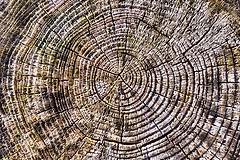In this informational text, elementary students learn how scientists use cross sections from trees to reconstruct past climates. The text also introduces students to Methuselah, a nearly 5,000 year-old bristlecone pine tree in CA and the oldest known living tree in the world. The text can be used in conjunction with the lessons featured in the article Lessons about Earth’s Past Climates and in the unit plan described in the article Unit Plans: Earth’s Climate Changes.
Versions of this text are available at the K-2 and 3-5 grade bands. The Flesch-Kincaid reading level of each version is provided following the text. Each version is available as a text only document (a downloadable PDF document), a full-color, illustrated book (downloadable PDF document), and an electronic book with recorded narration. You can use these various versions and formats as you differentiate instruction for your students.
GRADES K-2
Can You Read a Tree?
by Jessica Fries-Gaither
What’s the weather like now? Is it sunny? Maybe it’s rainy. Will it be the same tomorrow? You know that weather changes from day to day.
Climate can change, too. It just happens over long periods of time. A place might have been very different long ago. A cool place might have been warm. A warm place might have been cool. How can we know what the climate was like in the past?
Scientists keep track of the weather. They also read old journals that talk about what the weather was like. This tells them about the climate hundreds of years ago. But what about before that?
Trees can help us learn about climate. A tree’s trunk is made up of layers. Each layer looks like a ring. Every year, the tree adds a new ring as it grows. You can count the number of rings to find out how old a tree is.
Look carefully at the rings. They aren’t all the same size. Some are thick. Some are thin. Why are they different sizes?
Thick rings tell us that the tree grew a lot that year. The weather was good. It wasn’t too hot or too cold. There was just enough rain.
Thin rings tell us that the tree didn’t grow very much. The weather wasn’t good. Maybe it was too hot or too cold. Maybe there wasn’t enough rain.
Some very old trees grow in California. The trees grow on the sides of mountains. One of them is almost five thousand years old! We can learn a lot by studying these very old trees.
Go outside and look at the trees near your home or school. What can they tell you about the past?
Glossary
weather – what a place is like right now
climate – what a place’s weather is like over a long period of time
Flesch-Kincaid RL = 1.5
Access this Grades K-2 text as a text-only document.
Access this Grades K-2 text as a full-color illustrated book.
Access this Grades K-2 text as an electronic book.
Notes for assembling the illustrated books:
You can put this book together a couple of different ways. You can print out the pages, cut them in half and then order the pages back to front. Fold the stack in half and then staple the spine of the book. Pairs of pages can then be stapled or glued along the right edge.
You can also assemble the book as a foldable book.
To assemble the books this way, print the four pages and align the document pages so that the following book page numbers are in the lower right-hand corner: front page, page 6, page 2, and page 4. (The cover page should be on top and page 4 on the bottom.) Set your copier to copy single pages into double pages and run the four document pages in the order specified. Cut along the dotted line in the center of the double-sided page, place the book pages in order, fold, and staple along the spine.
GRADES 3-5
Can You Read a Tree?
by Jessica Fries-Gaither
What’s the weather like today? Sunny? Rainy? Snowy? What about yesterday? Was it the same or different? You probably know that weather changes from day to day. Sometimes it even changes from hour to hour!
Climate can change, too. It just happens over long periods of time. A place might have been very different long ago. A cool place might have been warm. A warm place might have been cool. How can we know what the climate was like long ago?
Scientists have kept records of the weather for the last two hundred years. To learn what the climate was like before that, they might have read old diaries or journals. A farmer might have kept a journal about when he harvested his crops each year. Another person might have written in a diary about when trees bloomed in spring.
But diaries and journals can only help so much. What about hundreds of thousands of years ago, before there were people at all? The secret to learning about Earth’s climate in the past can be found in surprising places, like giant trees.
The World’s Oldest Tree
In the White Mountains of California, a gnarled and twisted tree grows on the steep side of a mountain. Its name is Methuselah (meh-thoo-se-lah). It isn’t an ordinary tree. You see, Methuselah is nearly five thousand years old. It is the oldest-known living tree in the world.
Methuselah is a bristlecone pine tree. These long-living trees are found in only six states in the western United States. Their trunks are smooth from wind-blown sand and ice. They have yellow-green needles, like other pine trees. Bristlecones aren’t very tall. They grow to be only about sixty feet. Most of the tree’s energy is used to survive, instead of growing big.
Scientists think that Methuselah has been growing since 2832 B.C. Imagine all the things that have happened during this time. The pyramids were built in Egypt. The first Olympics were held in Greece. The Roman Empire ruled a large part of Europe. Christopher Columbus discovered America. America won its independence from Britain. And so on!
Why are trees like Methuselah important? They help scientists learn about Earth’s climate long ago. Here’s how.
Have you ever seen the inside of a tree? If so, you know that a tree’s trunk is divided into many circular sections, or rings. These tree rings can tell scientists how old a tree is. Each ring equals a year, so a tree with five rings is five years old. A tree with fifty rings is fifty years old.
Scientists also measure how wide the rings are. The width of the rings helps them understand what the climate was like during that year. A wide ring tells scientists that there was plenty of water and warm temperatures during the year. A narrow ring means that there wasn’t enough water or the temperatures were too hot or too cool.
Scientists don’t just study one tree’s rings to learn about the climate. Instead, they will study the rings of many trees in the area. The rings of all the trees will be similar. Scientists compare the rings to draw conclusions about what the climate was like for that place in the past. Scientists have done this in many places in North America and Europe. They know what the climate was like thousands of years ago.
Go outside and look at the trees near your home or school. What can they tell you about the past?
Glossary
climate – the average of the weather conditions through all the seasons over a period of time
gnarled – twisted, full of knots
weather – what it is like outdoors at a certain time
Flesch-Kincaid RL= 4.5
Access this Grades 3-5 text as a text-only document.
Access this Grades 3-5 text as a full-color illustrated book.
Access this Grades 3-5 text as an electronic book.
Notes for assembling the illustrated books:
You can put this book together a couple of different ways. You can print out the pages, cut them in half and then order the pages back to front. Fold the stack in half and then staple the spine of the book. Pairs of pages can then be stapled or glued along the right edge.
You can also assemble the book as a foldable book.
To assemble the books this way, print the four pages and align the document pages so that the following book page numbers are in the lower right-hand corner: front page, page 6, page 2, and page 4. (The cover page should be on top and page 4 on the bottom.) Set your copier to copy single pages into double pages and run the four document pages in the order specified. Cut along the dotted line in the center of the double-sided page, place the book pages in order, fold, and staple along the spine.
This article was written by Jessica Fries-Gaither. Jessica is an education resource specialist at The Ohio State University and project director of Beyond Penguins and Polar Bears. She has taught in elementary and middle school settings. Email Jessica at Email Jessica at beyondweather@msteacher.org.
Copyright July 2011 – The Ohio State University. This material is based upon work supported by the National Science Foundation under Grant No. 1034922. Any opinions, findings, and conclusions or recommendations expressed in this material are those of the author(s) and do not necessarily reflect the views of the National Science Foundation. This work is licensed under an Attribution-ShareAlike 3.0 Unported Creative Commons license.




